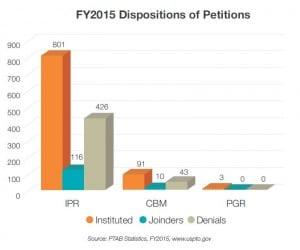Blog
PTAB Discretion Under 325(d) in Post-Grant Proceedings
The PTAB has interpreted the statutes and rules as giving it broad discretion as to whether to institute inter partes review. Under 35 U.S.C. § 325(d), the PTAB may reject a petition because "the same or substantially the same prior art or arguments previously were presented to the Office."10 In September 2014, the PTAB published seven opinions in which it denied a petition for inter partes review under § 325(d).
In some of those cases, the Board seems to be concerned about the Petitioner taking a "second bite at the apple." For example, the PTAB has denied a second petition challenging claims which were unsuccessfully challenged in a first petition, where the Petitioner relied on the same primary references used in the first petition, and added new evidence or prior art to specifically address the failings in the first petition.11 In denying these second petitions, the Board said that it did not want parties to file inadequate petitions and use the institution decision as a road map because "a decision to institute review on some claims should not act as an entry ticket, and a how-to guide, for the same Petitioner."12 Thus, it is important that the Petitioner carefully consider the strength of its case before filing a petition because it may not be able to correct deficiencies in a second petition. The Patent Owner, on the other hand, should evaluate and raise any § 325(d) issue in its preliminary response, especially if it seems that the second petition is addressing failures identified in an earlier denied petition.
The Board also seems keen to avoid duplicative or prejudicial proceedings. The PTAB has denied a second petition in which the Petitioner swapped out the primary reference in a first petition without explaining how the new reference differed from the original primary reference,13 and in which two of the three references in a second petition were the same as in the first petition, and were simply used in different combinations.14 The Board also denied a petition that impacted the timing of several related cases in which the Petitioner failed to address potential prejudice and all of the challenged claims were already the subject of instituted proceedings on the same grounds.15 Thus a Petitioner filing a second petition should consider discussing the reasons necessitating a second petition, the lack of burden, and the prejudice, if it is denied. Conversely, a Patent Owner raising § 325(d) under these circumstance should note the lack of prejudice to the Petitioner if the petition is denied.
At least one case indicates that the Board may also be reluctant to revisit arguments made in prosecution.16 Although this case may be an outlier, the Petitioner must remember that grounds that raise similar issues to those addressed during prosecution carry more risk of outright denial. A Patent Owner, on the other hand, can point out arguments that are similar to what was in the original prosecution or reexamination.
The Board, under § 325(d), will likely continue to frown on petitions that repeat earlier arguments or duplicate the proceedings. Petitioners should be mindful of these considerations when filing an IPR, particularly when trying to remedy the deficiency of a previously denied petition by using the same art or arguments. This area of practice should continue to evolve as the PTAB considers a wider range of facts under § 325(d).
This article originally appeared in Fish's 2015 Post-Grant Report. Read the full report here.
The opinions expressed are those of the authors on the date noted above and do not necessarily reflect the views of Fish & Richardson P.C., any other of its lawyers, its clients, or any of its or their respective affiliates. This post is for general information purposes only and is not intended to be and should not be taken as legal advice. No attorney-client relationship is formed.
